Dance played a significant role in traditional Filipino courtship rituals, serving as a crucial means of communication.
Filipino courtship dances conveyed emotions and intentions through subtle movements and props. The Cariñosa, for example, utilized fans and handkerchiefs to express flirtation. Regional variations, such as the playful Kuratsa and the more formal Pantomina, reflected unique cultural nuances and social structures, allowing participants to express their feelings and intentions in a socially acceptable manner.
These dances actively involved communities in validating relationships and transmitting cultural values**. The symbolism within the movements and props further enriched their communicative power, allowing participants to convey complex emotions and intentions. The Kuratsa, for instance, symbolized a couple's courtship journey, while the Pantomina represented the couple's commitment to marriage. By understanding these intricacies, one can gain a deeper appreciation for the significance of dance** in Filipino courtship rituals and their role in shaping the country's cultural heritage.
Traditional Courtship Dances
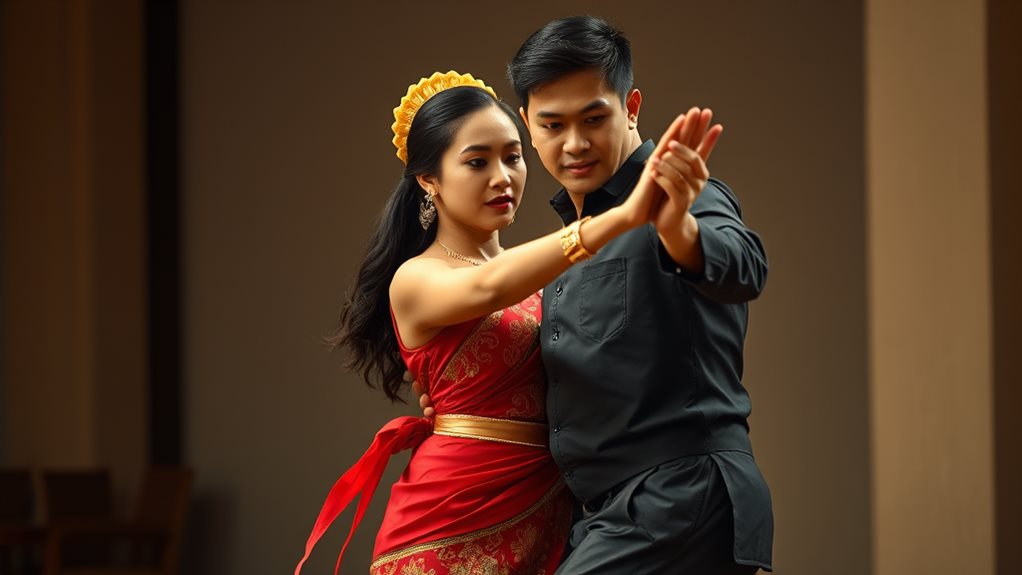
Traditional Filipino Courtship Dances Reflect Unique Regional Customs****
Filipino courtship traditions are richly expressed through various dances, each reflecting unique regional customs and styles. The Kuratsa, Cariñosa, Pantomina, and Taduk are four notable examples of these dances.
The Kuratsa: A Playful Visayan Dance****
The Kuratsa originates from the Visayas and is a playful dance showcasing flirtatious movements and energetic steps. This dance reflects the vibrant culture of the region, typical of Visayan social gatherings.
The Cariñosa: A Spanish-Influenced Dance****
The Cariñosa, introduced by the Spaniards, means "loving one." This dance depicts colonial-era courtship**** with fans and handkerchiefs, utilizing hide-and-seek movements that highlight the subtle nature of courtship.
Regional influences are apparent in the subtle variations and interpretations across different Visayan communities.
The Pantomina: A Bicolano Wedding Dance****
The Pantomina, originally a Bicolano wedding dance, is also performed in Mindanao. This dance involves intricate steps and gestures, mimicking the courtship of doves, and traditionally involves the tossing of coins.
Its evolution reflects shifting cultural influences, as it was known as "Salampati" during the Spanish occupation.
The Taduk: A Traditional Isneg Tribe Dance****
The Taduk, from the Isneg tribe of Apayao, highlights traditional gender roles. This dance features men playing gongs while skipping, accompanied by unmarried women in a circular formation.
Its preservation reveals the importance of indigenous courtship rituals within a specific tribal context.
Regional Influences and Cultural Significance****
These dances offer glimpses into diverse cultural practices and beliefs surrounding courtship in the Philippines. They reflect the adaptation and evolution of courtship traditions****, highlighting the unique characteristics of each region.
Philippine Dance Variations
Regional Variations in Philippine Dance****
Philippine dance is characterized by a rich tapestry of regional styles. One such style is the Visayan style, which is marked by lively energy and playful gestures****. This style is a blend of indigenous and Spanish influences, often performed during festive occasions. The Visayan style combines traditional Filipino movements with Spanish-inspired steps, resulting in a unique form of rhythmic expression.
Mindanao's dances display intricate hand movements and footwork, showcasing a blend of indigenous Muslim and Christian traditions with Spanish and American influences. Traditional instruments like the agong and kulintang are often incorporated alongside Spanish guitar and American jazz rhythms. For example, the dance Panglay sa Agong exemplifies the region's unique dance storytelling, portraying narratives of courtship and competition.
Tribal dances offer a glimpse into the rich cultural heritage of various indigenous groups. The Yakan's Tahing Baila is a dance that imitates fish movements, showing rhythmic expression.
Another example is the Pangsak dance, which features complicated hand and foot movements and painted faces, showcasing a different form of dance storytelling. Other tribal dances include the Binaylan, which emulates a hen, her chicks, and a hawk, and the Bagobo Rice Cycle dance, which portrays agricultural rituals.
Regional variations in Philippine dance are numerous. Examples include the Bendayan from Benguet and the Manmanok from Bago.
These dances utilize unique movements as a primary form of storytelling, enriching the diversity of Philippine dance.
Luzon Island's Dances
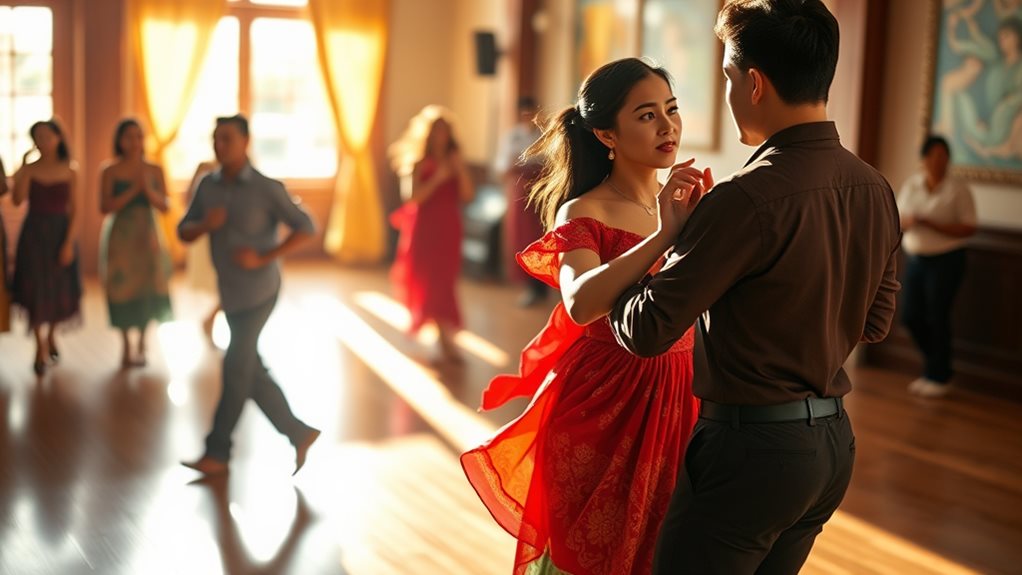
Luzon Island is home to a diverse collection of traditional dances that reflect its rich cultural heritage and history.
These dances often feature courtship themes, such as the flirtatious Carinosa, where fans mimic a playful, hard-to-get romance. Another example is the La Jota Moncadena, a blend of Spanish and Filipino styles that incorporates castanets and bamboo poles, often within a courtship context. The Jotabal, a lively festival dance stemming from the Jota and Valse, also sometimes incorporates courtship rituals.
The evolution of Luzon's dances is evident in the variety of styles. For instance, the Maglalatik is a mock-war dance that showcases the area's cultural heritage, while the Banga is a contemporary Kalinga performance. Dances like the Sayaw sa Bangko, which requires exceptional balance, and the Bindian, a victory dance, are part of broader cultural celebrations that sometimes include courtship.
Other notable dances include the Pandanggo sa Ilaw and Binasuan, which demonstrate incredible balance and skill and often appear in festive occasions that might involve courtship.
The diversity of Luzon's dances highlights the interplay of artistic expression, social interaction, and unique courtship practices in the region.
These traditional dances often feature in social gatherings and celebrations, such as the Balse, a waltz that appears in social gatherings, including courtship, particularly following religious processions. The Chotis, a ballroom dance adapted by the Bicolano people, also appears in social settings where courtship might occur.
The unique courtship practices and cultural heritage of Luzon's diverse communities are reflected in these traditional dances.
The evolution of Luzon's dances is a testament to the region's rich cultural history and the importance of artistic expression in its communities.
Visayas's Dance Traditions
The Visayas' Rich Dance Traditions
The Visayas is home to a diverse array of dance traditions, reflecting a blend of indigenous practices, Spanish colonial influences, and evolving societal norms. This blend of influences is evident in the region's various dance forms.
Dance Storytelling
Dance storytelling plays a significant role in Visayan culture, conveying narratives of daily life, rituals, and romantic pursuits. Examples of narrative dances include *Itik-Itik*, which mimics ducks' movements, and *Mananguete*, which depicts coconut wine production. Other dances like *Ohong-Ohong* and *Mananagat* offer glimpses into Visayan life and traditions.
Visayan Courtship Dances
Visayan courtship is often expressed through elegant, symbolic movements. Dances like *Kuratsa*, which imitates rooster and hen courtship, and *Alkamfor*, which uses a camphor-laced handkerchief for flirtatious interaction, directly address courtship. The *Cariñosa*, of Hispanic origin, employs hide-and-seek movements, while the *Surtido Cebuano* incorporates elements of romance. Additionally, *Kinaransa* features an intimate embrace, further illustrating the dynamic of Visayan courtship.
Types of Visayan Dances
Visayan dances can be categorized into four main types:
| Dance Type | Example Dance(s) | Description |
|---|---|---|
| Courtship Dances | Kuratsa, Alkamfor, Cariñosa | Depict flirtation, pursuit, and romantic gestures. |
| Mimetic & Narrative | Itik-Itik, Mananguete, Mananagat | Mimic natural phenomena, occupations, or storytelling through movement. |
| Ritual & Worship | Sinulog, Troupe Sinulog | Integrated into religious and cultural ceremonies. |
| Cultural Influences | Surtido Cebuano, Lawiswis Kawayan | Blend indigenous, Spanish, and other influences.
Mindanao's Dance Expressions
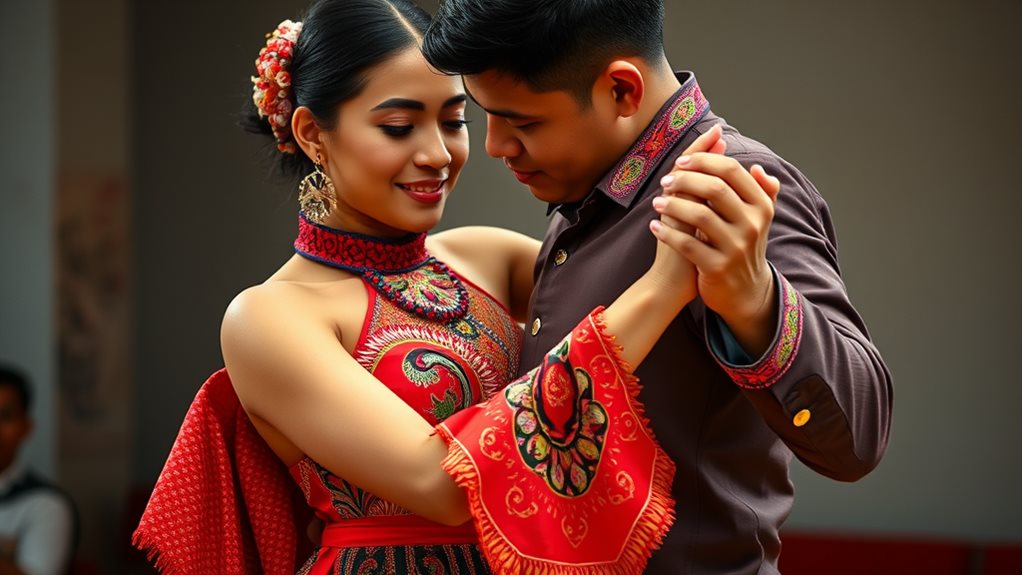
Mindanao's Dance Traditions: A Reflection of Cultural Diversity****
Mindanao's diverse cultural landscape is reflected in its rich tapestry of dance traditions. Each dance expresses unique stories and cultural values, showcasing intricate traditional movements and rich symbolism.
Storytelling through Dance
Mindanao dances are more than performances; they're integral to social gatherings and community identity. The Karasaguyon dance, for example, depicts the pursuit of a polygamous man by four sisters, highlighting gender portrayals within courtship narratives.
Similarly, the Kadal Heroyon, performed by T'boli girls, imitates bird movements, symbolizing beautification and courtship.
Dance and Community
Dances like the Panglay ha Pattong, a Badjao dance, and the Panglay sa Agong, performed by the Tausug tribe, strengthen social bonds and reinforce cultural values.
The Panglay ha Pattong uses bamboo poles to mimic boat movements, showcasing skillful balance, while the Panglay sa Agong showcases warriors competing for a woman's attention using gongs.
Symbolism and Cultural Significance****
Dances often incorporate spiritual practices and supplications, further enriching their cultural significance. The Dinuyya, performed by the Bagobo tribe, uses animal movements to symbolize community well-being.
These dances serve as powerful vehicles for transmitting local legends, history, and values across generations.
Performances and Props
Costumes and musical accompaniment enhance the performances, adding layers to the already complex interplay of movements and stories.
Each dance is a unique blend of movement, music, and symbolism, showcasing the rich cultural heritage of Mindanao.
Ilocos Region's Courtship
Ilocano Courtship: A Blend of Tradition and Modernity
The Ilocos Region's courtship tradition is a unique blend of time-honored customs and modern influences. This tradition encompasses various practices beyond cultural dances.
Traditional Ilocano Courtship Practices
Traditionally, an Ilocano man would serenade his beloved (harana) and perform acts of servitude (panag-serbi) for her family. He would also provide material support, love letters, and gifts to solidify his commitment. Family approval was paramount, as it played a crucial role in the courtship process.
The Role of Technology in Modern Ilocano Courtship
Modern Ilocano courtship has integrated technology, with texting and social media becoming essential tools. Despite this shift, respect for elders and traditional practices like parental consent remains integral. This blend of old and new creates a dynamic courtship process that can range from casual dating to years-long engagements.
Key Aspects of Ilocano Courtship
The following table highlights the key aspects of Ilocano courtship:
| Traditional Practices | Modern Adaptations | Family & Parental Roles |
|---|---|---|
| Harana (Serenade) | Online communication (chatting) | Parental consent is crucial |
| Panag-serbi (Servitude) | Maintaining traditional values | Dowry and wedding finances |
| Material support (gifts) | Social media courtship | Formal announcements (panagpudno) |
| Love letters | Combining old and new methods | Setting wedding dates |
The Enduring Strength of Family and Community
While technology has altered communication, the core values of respect, family involvement, and material security endure in Ilocano courtship. The process, whether traditional or modern, culminates in a wedding sanctioned by both families, underlining the enduring strength of family and community in Ilocano life.
Cebuano Courtship Customs
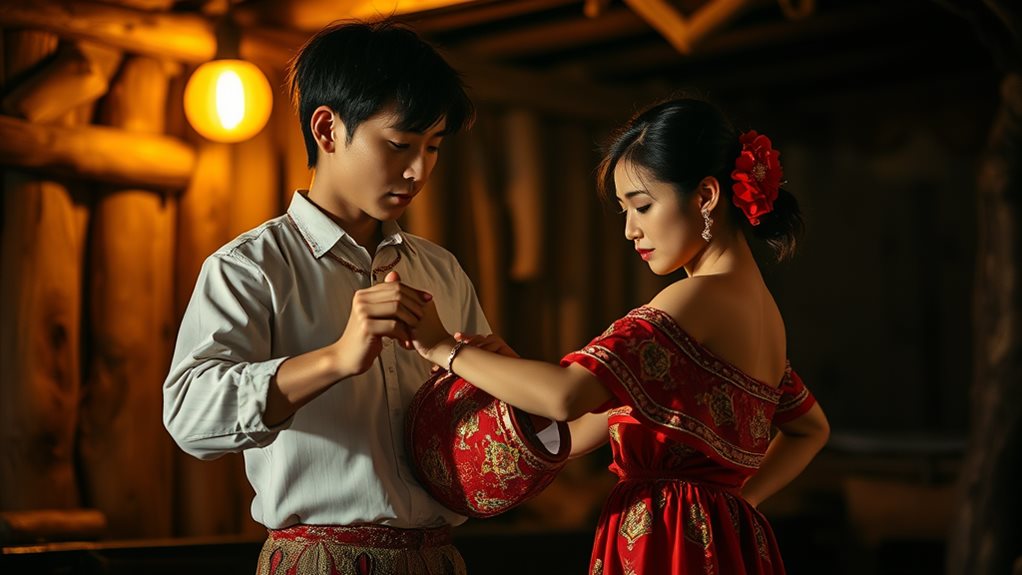
Cebuano Courtship Customs: A Blend of Music, Dance, and Tradition
Cebuano courtship customs are a unique blend of musical and dance traditions, woven together with customary practices. A key element is Cebuano serenading, or balak, where romantic songs are sung to the intended woman. This musical expression is often accompanied by intermediaries who deliver Cebuano love letters, adding another layer to the courtship process.
In Cebuano courtship, gifts are exchanged not only with the woman but also with her family, highlighting the importance of family involvement and approval. Additionally, Cebuano love potions may be used, similar to practices in other regions.
Cebuano courtship rituals are deeply rooted in cultural significance. Formal requests, often involving musicians, mark a significant progression in the courtship. These formal visits demonstrate respect and seriousness of intent, showcasing the importance of community approval.
The elaborate dances themselves aren't just entertainment but also subtle displays of affection, skill, and social standing.
Symbolism in Dance
Filipino courtship dances utilize symbolism to convey deeper meanings beyond mere entertainment.
The use of symbolism in these dances reflects cultural motifs and societal values. In the Cariñosa dance, elegant gestures and swaying movements represent flirtatious interactions and the careful dance of courtship. Accessories like fans and handkerchiefs add another layer of symbolic meaning, representing romantic scenarios and subtle communication.
Costumes play a crucial role in Filipino courtship dances, symbolizing national identity and cultural fusion. The Maria Clara gown, for example, represents both nationalism and the Spanish colonial influence. The Barong Tagalog for men similarly represents the cultural amalgamation of the era.
| Dance Element | Symbolism | Example Dance |
|---|---|---|
| Movements | Courtship rituals, affection, respect | Cariñosa |
| Costumes | National identity, cultural fusion | Cariñosa, Asik |
| Community Participation | Social bonding, community approval | Asik |
| Music & Instruments | Emotions, intentions, cultural expression | Asik |
The Asik dance, for example, showcases the Kalinga people's unique traditions through its synchronized movements and the use of traditional instruments. These rhythmic patterns convey emotions and intentions, integral to the dance's storytelling. The public nature of the Asik dance emphasizes its social significance: a public declaration of intent and a strengthening of community bonds.
Filipino courtship dances are not merely performances but powerful expressions of cultural identity, social values, and romantic aspirations. Understanding this dance symbolism provides a deeper appreciation of Filipino courtship traditions.
Dance Props and Meanings
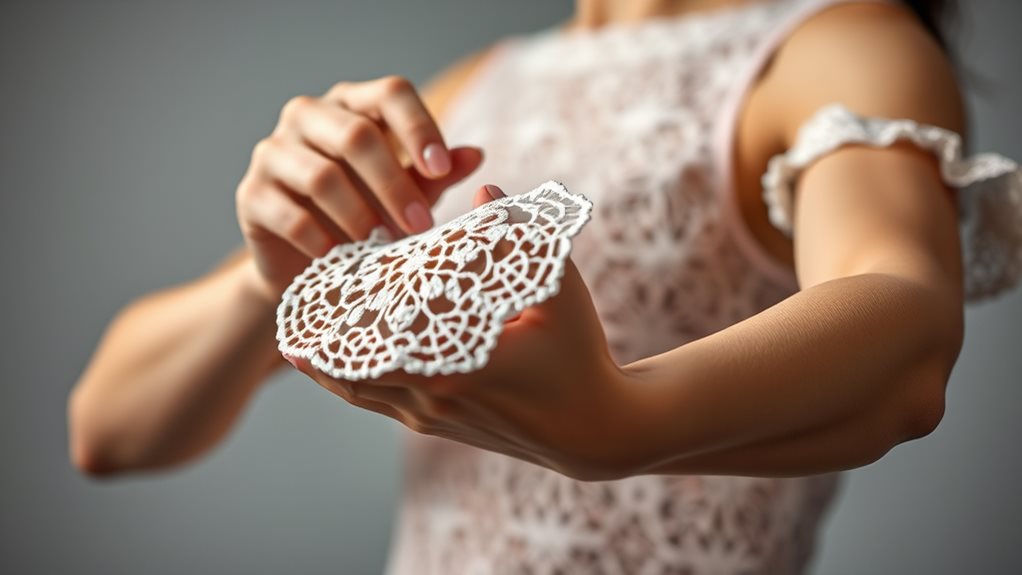
Filipino courtship dances rely heavily on props to convey their symbolic narrative. The props are integral to the dance's meaning, and their significance isn't just decorative.
In the Cariñosa dance, for example, the fan represents shy and modest behavior, while the handkerchief symbolizes playful hide-and-seek elements. The fan, wielded by the female dancer, and the handkerchief, held by the male dancer, add to the overall narrative of the dance. Bamboo castanets may also be used to add rhythmic emphasis****.
The costumes, typically vibrant Maria Clara gowns and Barong Tagalog, represent cultural heritage and Spanish colonial influence****.
The use of props in these dances serves as a form of nonverbal communication. The subtle movements of the props convey emotions and intentions that words can't fully capture. For instance, a flirtatious wave of the fan or a furtive peek behind a handkerchief can convey the emotions and intentions of the dancers.
Regional variations of these dances may incorporate local props, but the core prop significance remains consistent: a playful and subtle expression of romantic interest****.
Performance and Participation
Filipino courtship dances showcase a rich cultural tradition through performance styles and participatory traditions. These dances aren't merely performances; they're vehicles for expressing emotions and intentions. The partner dynamics are central, reflecting the courtship's progression. For example, the Binasuan demonstrates coordination and control through skillful balancing acts, while the energetic movements of the Sinulog display vibrant cultural pride.
The level of participation in Filipino courtship dances varies greatly. Some dances, like the Pantomina, directly engage couples and their families, transforming the performance into a shared celebration. This inclusion of family members adds another layer of meaning to the dance interactions, highlighting the importance of kinship in Filipino culture. For instance, the Pantomina involves the couple and their families, demonstrating the significance of family involvement in courtship.
Dances also symbolize the affections, negotiations, and bonding of a couple. The movements themselves mirror partner dynamics, showcasing a rich cultural tradition through movement and shared experience. The Carinosa, for example, features flirtatious movements, while the Habanera Botolena showcases intricate footwork, highlighting the diverse dance interactions in Filipino courtship.
Community Dance Involvement
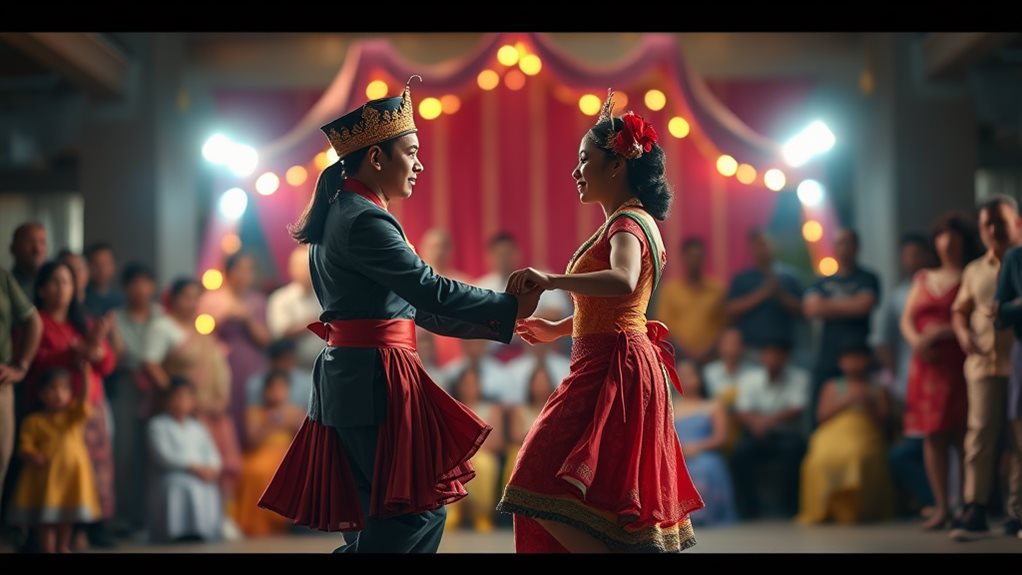
Community involvement plays a crucial role in Philippine courtship dances**, influencing the way couples interact and shaping social dynamics. In these traditional dances, community engagement isn't just about witnessing the performance; it's an active participation that reinforces social validation** and strengthens community bonds.
The community's active role in observing and responding to the dance is a key aspect of this involvement. For example, in the dance Pantomina, community members toss coins to reinforce social validation and strengthen community bonds**. This active participation transforms the dance into a form of public declaration, subjecting the couple's actions to collective scrutiny** and approval.
The public nature of these dances ensures that the couple's actions conform to established social expectations**. The community's presence during the dance serves as a reminder of the cultural norms and expectations that the couple must adhere to. This, in turn, ensures the couple's actions are guided by the community's values**.
Community involvement in Philippine courtship dances also serves as an educational tool. Younger generations learn about courtship rituals, social norms, and cultural heritage**** by witnessing these dances. This collective participation underscores the significance of these dances, not just for the couple, but for the entire social fabric.
The multifaceted community engagement in Philippine courtship dances is crucial for social cohesion and cultural transmission. These dances aren't merely romantic expressions but essential components of the community's social structure.
Cultural Dance Significance
Filipino traditional dances reflect and shape the country's culture through a rich interplay between indigenous traditions and cultural exchange. This interplay is evident in the evolution of dances, which showcases diverse regional styles and historical influences.
Filipino dances have a diverse regional background, as shown in the table below:
| Dance | Region | Theme | Significance |
|---|---|---|---|
| Kuratsa | Visayas | Playful courtship | Lively, flirtatious interaction between partners |
| Salidsid | Luzon (Kalinga) | Rooster and hen courtship | Imitates animal courtship rituals, symbolizing male-female relationships |
| Pantomina | Bicol | Dance of the doves | Simulates bird courtship and showcases courtship rituals |
| Soryano | Palawan | Anxious male pursuit | Portrays male persuasion tactics and anxiety in relationships |
These dances often symbolize courtship rituals and emotions like love and anxiety through movement. For example, the Kuratsa and Pantomina directly express these emotions, while the Kadal Heroyon and Pangalay mirror bird movements, highlighting nature's influence.
The evolution of Filipino dances reflects both continuity and change. While some dances retain ancient symbolism, others show the impact of cultural exchange, particularly with Spain. The incorporation of Spanish influences, evident in dances like La Jota Moncadeña, speaks to the complex historical interactions shaping Filipino identity.
These dances represent a living cultural legacy, passed down through generations and continuously reinterpreted. They are not merely entertainment but also play a significant role in the community, underscoring the importance of family and societal approval in courtship.
Preserving Filipino Heritage

Preserving Filipino traditional dances requires a multifaceted approach. It involves community involvement, formal education, and widespread public engagement to ensure the continuation of these cultural traditions.
Continued practice within families and communities is crucial for preserving traditional dances. Teaching these dances to younger generations is a form of cultural storytelling that keeps the legacy alive. For example, families can practice traditional dances together during celebrations and special events.
Structured learning environments play a vital role in preserving traditional dances. Schools and dance companies provide these environments, where students can learn and appreciate the significance of traditional dances. Educational programs in schools integrate traditional dances into the curriculum, teaching students about their cultural importance.
Documenting traditional dances is also essential for preservation. Systematic documentation creates a lasting archive of the dances. This includes recording the steps, music, and costumes associated with each dance. For instance, dance companies can create instructional videos and books that detail the steps and history of each dance.
National and regional festivals offer a platform for showcasing traditional dances. Participating in these events helps preserve the traditions. By supporting and engaging with these events, individuals contribute to the preservation of Filipino heritage.
A holistic approach is necessary for the preservation of traditional dances. This approach combines education, community involvement, and performance to ensure the continuation of these cultural traditions. For example, schools can partner with local dance companies to provide students with opportunities to learn and perform traditional dances.
Courtship Rituals and Dances
Filipino traditional dances often serve as elaborate courtship rituals, encoding complex social interactions and cultural values through movement. These dances convey emotions and intentions beyond words through a combination of gestures and expressions. For example, the Cariñosa uses elegant movements to represent subtle courtship, showcasing trust and respect between partners through intricate steps and gentle pressure.
Regional variations of Filipino dances reflect diverse cultural nuances. The Pantomina, also known as the "Dance of the Doves," simulates avian courtship, while the Kuratsa, from the Visayas, is known for its lively and flirtatious interactions. The Singkil, a Maranao dance, incorporates precise footwork around bamboo poles, symbolizing the challenges and grace in courtship.
The characteristics of these dances can be summarized as follows:
| Dance | Region | Key Characteristics |
|---|---|---|
| Cariñosa | Nationwide | Elegant, flirtatious movements, subtle cues |
| Pantomina | Varies | Simulates bird courtship, often at weddings |
| Kuratsa | Visayas | Lively, playful interactions between partners |
These dances are not just performances but active participations in cultural heritage. They are often performed at weddings, emphasizing social bonding. Traditional music and costumes enhance the symbolic nature of the courtship rituals. Modern adaptations have ensured the continued relevance of these dances, bridging tradition and contemporary expression.
These traditional dances have become integral to Filipino culture's identity and history, serving as a powerful testament to courtship rituals over generations.
Serenading and Other Customs
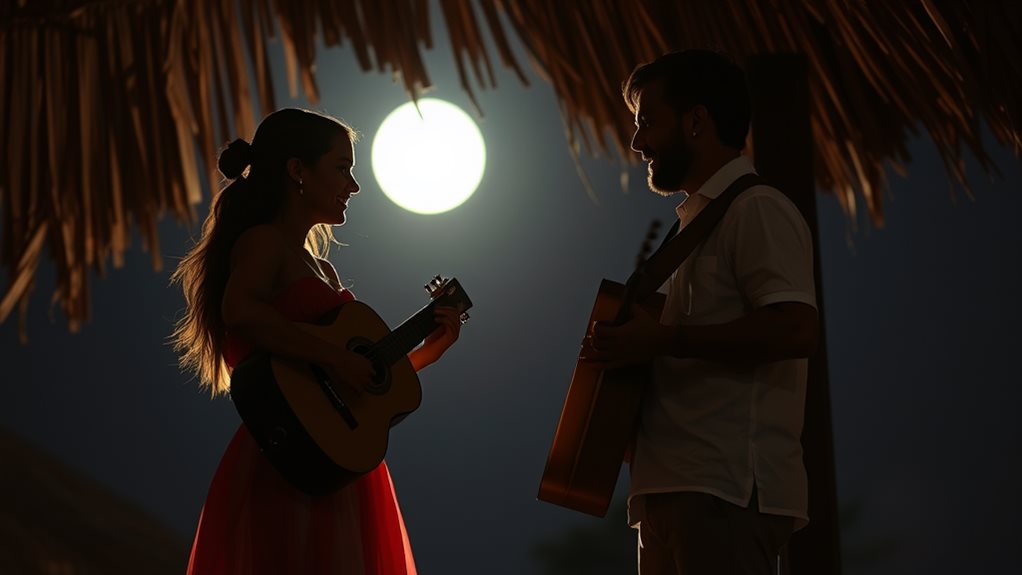
Traditional Filipino Courtship and the Significance of Serenading****
In traditional Filipino courtship, serenading, known as *harana*, plays a vital role in the relationship-building process. The primary significance of *harana* lies in its ability to convey deep emotions through music and lyrics.
A typical *harana* takes place at night, under the moonlight, outside the woman's window. The guitar is the preferred instrument, providing an intimate soundscape for the serenade. The songs are often in the kundiman form and use archaic Tagalog to express the suitor's feelings. Before the serenade, the suitor may seek permission from the woman or her family, demonstrating respect for their wishes.
In some cases, the suitor may hire skilled musicians, known as *haranistas*, to ensure a successful serenade. These musicians would orchestrate the event in stages, including a call, a proposal, and a farewell. The woman's response to the serenade is crucial, as opening her window may be an invitation for the suitor to enter her home. The woman's family also plays a significant role in the process, observing and providing support.
The *harana* tradition has been influenced by Spanish culture, evident in its rhythmic structure. It flourished in the 1930s, incorporating various regional styles. Despite its decline, modern revivals have kept the *harana* alive, highlighting its enduring cultural impact.
The *harana* is more than just a musical performance; it's a formalized process reflecting cultural values and social expectations. It showcases the expressive power of music in courtship rituals and the role of community in shaping romantic relationships.
Questions and Answers
How Has Modern Dating Changed Courtship Dances?
Modern dating has changed courtship dances by incorporating informality and cultural adaptation.
Courtship dances have traditionally been formal and ritualistic. However, with the rise of modern dating, these dances have evolved to become less formal. This shift in formality has led to a decrease in the frequency of traditional courtship dances.
Despite this decrease, the cultural significance of courtship dances persists. For example, the waltz, a traditional European courtship dance, is still performed at weddings and formal events. However, its style and theme have adapted to blend with contemporary styles.
For instance, modern couples often incorporate popular music and choreography into their wedding dances, making them more personal and unique. This blending of traditional and contemporary styles allows courtship dances to remain relevant in modern dating.
Are These Dances Still Taught to Younger Generations?
These traditional dances are indeed still taught to younger generations. They are passed down through various channels, including educational institutions, community programs, and family gatherings. This transmission ensures the dances' survival and highlights their ongoing cultural significance. For instance, schools often incorporate traditional dance lessons into their physical education or cultural studies curricula. Similarly, community centers and cultural organizations offer classes and workshops where younger generations can learn these dances from experienced instructors and family members.
What Are the Biggest Challenges to Preserving These Dances?
Preserving traditional dances is threatened by several key challenges. Cultural appropriation is one major issue, where these dances are often adopted by other cultures without proper understanding or credit. For instance, traditional Native American dances have been misused in various contexts, such as music videos and fashion shows, without acknowledging their cultural significance.
Another challenge is dwindling community engagement, where younger generations are less interested in learning and practicing these dances. This can be seen in the decline of traditional dance classes and workshops in many communities.
Limited funding is also a significant obstacle, as many organizations and communities lack the resources to promote and preserve these dances. This can result in a lack of opportunities for dancers to learn and perform these dances.
Lastly, globalization's homogenizing effects can lead to the loss of cultural diversity and traditional dances. As global cultures become more interconnected, local traditions may be overshadowed by more dominant cultural influences.
Do Any Dances Focus on Same-Sex Courtship?
In traditional Filipino dances, same-sex courtship is not depicted.
Filipino dances traditionally focus on opposite-sex relationships and do not include same-sex expressions. This is evident in the cultural significance of their dances, which are centered around heterosexual relationships and courtship.
Which Dance Is Easiest to Learn for Beginners?
Pantomina is the easiest dance to learn for beginners. This dance is characterized by basic steps and a slow rhythm, making it beginner-friendly. For example, its steps are often a combination of a series of slow, swaying movements that are easy to follow. Additionally, Kuratsa's waltz is also considered an accessible dance for beginners, with a waltz-inspired rhythm that is simple to learn and master.